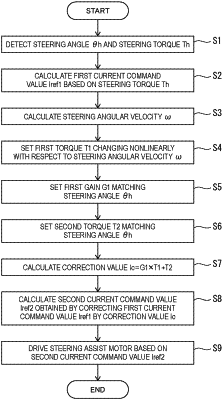| CPC B62D 5/0472 (2013.01) [B62D 5/0469 (2013.01)] | 15 Claims |

|
1. A control device comprising:
a memory that stores a set of instructions; and
at least one processor configured to execute the set of instructions to:
calculate a first current command value, the first current command value causing an actuator to generate steering assist torque, based on at least steering torque;
when an absolute value of steering angle is greater than or equal to a threshold value, calculate a correction value for suppressing increase in an absolute value of the steering angle by correcting the steering assist torque;
calculate a second current command value obtained by correcting the first current command value by the correction value; and
drive the actuator, based on the second current command value,
wherein the correction value is calculated, based on first torque, the first torque changing nonlinearly with respect to steering angular velocity,
wherein the first torque is zero in a range where steering angular velocity is lower than a first steering angular velocity and changes from zero to a nonzero value at the first steering angular velocity,
wherein a rate of change of the first torque with respect to the steering angular velocity in a range between a second steering angular velocity, the second steering angular velocity being higher than the first steering angular velocity, and the first steering angular velocity is larger than a rate of change of the first torque with respect to the steering angular velocity in a range between a third steering angular velocity, the third steering angular velocity being higher than the second steering angular velocity, and the second steering angular velocity, and
wherein a rate of change of the first torque with respect to the steering angular velocity in a range greater than or equal to the third steering angular velocity is larger than a rate of change of the first torque with respect to the steering angular velocity in a range between the third steering angular velocity and the second steering angular velocity.
|